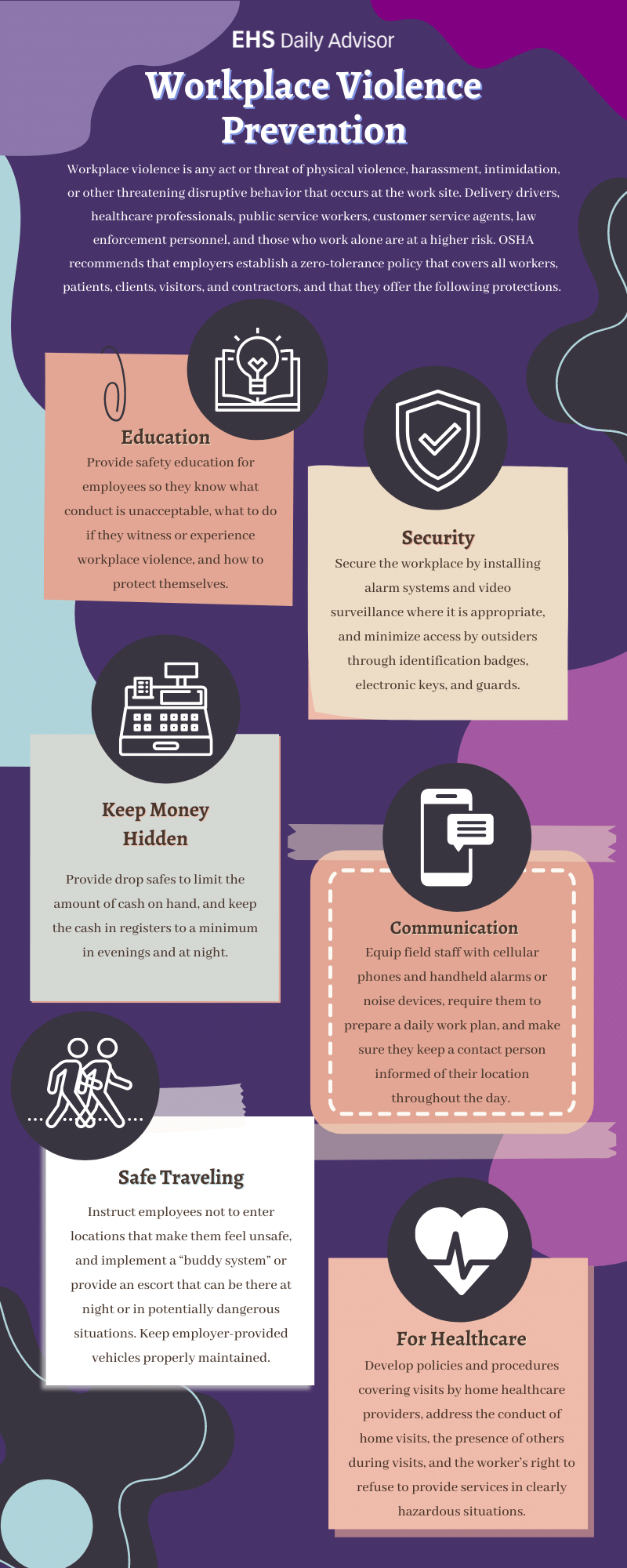Comprehending Legal Requirements for California Workplace Violence Prevention Programs
The Role of Employee Training and Understanding in Enhancing Office Violence Prevention Initiatives Across Different Industries
The assimilation of staff member training and understanding right into office physical violence prevention initiatives is significantly recognized as an essential element of business safety and security throughout diverse sectors. Comprehending these nuances might reveal methods that can considerably boost safety methods and worker confidence in risky settings.
Value of Educating Programs
In today's dynamic workplace, the relevance of training programs can not be overstated, especially in the context of workplace violence avoidance. These programs serve as a foundational aspect in growing a safe and safe and secure workplace society. By gearing up staff members with the knowledge and skills needed to recognize, mitigate, and respond to possible threats, organizations can cultivate an environment that prioritizes safety and well-being.
Efficient training programs do greater than just instruct; they equip employees to recognize indication of violence, recognize the methods for reporting occurrences, and establish methods to de-escalate potential disputes. Additionally, they instill a feeling of collective responsibility amongst personnel, encouraging aggressive involvement in keeping a risk-free work environment.
Financial investment in training not only improves employee understanding yet likewise demonstrates an organization's dedication to protecting its labor force. This positive approach can result in minimized cases of workplace violence, lower absenteeism, and enhanced staff member spirits. Inevitably, comprehensive training programs are important to developing a resistant business culture that values safety and promotes a healthy job setting, thereby decreasing the danger of physical violence and its linked effects.
Key Components of Effective Understanding
A thorough awareness program incorporates numerous crucial parts that are important for efficiently stopping office physical violence. First, clear communication of policies and treatments related to work environment violence is essential. Staff members should be notified about the company's position on physical violence and the particular protocols in position for reporting cases.
Second, training sessions must include reasonable situations that workers might come across. This useful technique assists staff members acknowledge alerting indications of possible physical violence and furnishes them with the required abilities to de-escalate strained circumstances. Third, fostering a supportive workplace culture is vital; staff members ought to really feel equipped to talk up without anxiety of retaliation.
Additionally, ongoing education and learning is essential to keep recognition fresh and appropriate. Regular refresher training courses and updates on emerging risks can boost employees' alertness and preparedness. Finally, including comments devices enables staff members to share their insights and experiences, which can lead to constant enhancement of recognition initiatives. By incorporating these elements, companies can create a robust structure for avoiding workplace physical violence, ultimately contributing to a safer and more effective atmosphere for all workers.
Industry-Specific Training Strategies
Efficient office physical violence prevention training should be tailored to the special challenges and risks dealt with by details markets. Medical care environments require training that attends to the high likelihood of encounters with aggressive individuals or visitors. Programs need to focus on de-escalation techniques, recognizing indication of prospective physical violence, and guaranteeing team realize the significance of reporting occurrences.
On the other hand, retail settings may deal with different risks, such as break-in or client disagreements. Training in these environments ought to emphasize situational recognition, reaction methods during emergencies, and the significance of securing cash money and belongings.
Manufacturing and building and construction industries present their own dangers, often connected with social disputes or unsafe working problems. Training in these sectors ought to consist of strategies for dispute resolution, advertising a culture of security, and urging open communication amongst employees.
Furthermore, company offices may call for training centered on avoiding harassment and intimidation, fostering a respectful work environment society, and executing clear reporting devices. Each industry should not just identify its specific susceptabilities yet additionally adapt training products to reverberate with the workforce properly, making sure that staff members feel complete and encouraged to deal with potential violent situations.
Gauging Training Effectiveness
Evaluating the impact of office physical violence prevention training is crucial for making sure that staff members read are appropriately prepared to deal with possible dangers. To precisely gauge training performance, companies should implement both qualitative and quantitative assessment methods. Pre- and post-training studies can gauge adjustments in staff member knowledge, mindsets, and actions concerning work environment violence. These surveys need to concentrate on details training objectives to ensure positioning with the company's objectives.
In addition, sensible analyses, such as role-playing circumstances or simulations, can give understandings right into just how well employees use learned skills in real-life situations. Keeping an eye on incident reports before and after training can also function as an indicator of effectiveness, as a decrease in cases might show enhanced employee preparedness.
In addition, comments from individuals ought to be systematically accumulated to determine locations for renovation in training material and delivery. Performing follow-up assessments at normal periods helps endure awareness and reinforces training concepts in time - california workplace violence prevention. By utilizing a thorough method to gauging training efficiency, organizations can ensure that their work environment physical violence avoidance initiatives foster a much safer atmosphere and improve total staff member well-being
Building a Culture of Safety

Educating plays an essential duty in this cultural change. Normal, extensive training sessions enlighten employees about recognizing warning indications of office violence and the appropriate reactions. Moreover, motivating open interaction permits employees to voice issues without worry of revenge, advertising cumulative responsibility for security.
In addition, integrating safety into daily operations guarantees that it comes to be a common value as opposed to a mere compliance problem. This consists of routine safety and security drills, updates on plans, and feedback mechanisms that involve staff members in safety and security discussions and renovations.
Inevitably, a durable society of safety not only mitigates the risks of work environment physical violence but also improves staff member spirits and performance. By promoting a setting where safety and security is a basic top priority, companies can produce resilient work environments that sustain both specific wellness and cumulative success.
Final Thought
In final thought, staff member training and understanding are vital elements in the prevention of work environment violence throughout different industries. Effective training programs, customized to specific market demands, improve workers' ability to react and recognize to potential threats.

Regular, extensive training sessions inform staff members regarding acknowledging warning indications of workplace violence and the proper feedbacks.In conclusion, worker training and recognition are important parts in the avoidance of work environment physical violence across various markets.